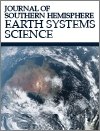Journal of Southern Hemisphere Earth Systems Science
Volume 73
Number 1 2023
The influence water currents have on wind speeds was investigated for Shark Bay, Western Australia. It was shown that the standard weather forecasting program, the WRF, overestimates strong winds when the tide is incoming. It is proposed that this is due to the higher waves generated when the tidal current opposes the prevailing wind. Improvements to the model would involve taking this effect into account.
Atmospheric chemistry is an important component of the climate system – particularly in the southern hemisphere where the ozone hole has been present for many decades. Simulations of ozone by climate models that incorporate chemistry have had mixed results; however, in this paper we show that our model simulates ozone depletion very well. Accurate chemistry–climate models will be crucial in projections of future climate, allowing us to investigate the interplay between the recovery of the ozone layer and greenhouse gas driven warming.
The climate is unequivocally warming, and the amount of warming since the pre-industrial era is now a key metric of climate change, including the 1.5 and 2°C targets specified in the Paris Agreement. This paper lays out our best estimates of how much Australia has warmed since pre-industrial, and how it is projected to warm under future scenarios.
The traditional seasons of summer, autumn, winter and spring are a poor match to actual weather patterns in the Sydney Basin. Indigenous Knowledge, historical weather data and a statistical clustering technique were used to identify a more-appropriate set of pseudo-seasons. These were better able to identify times of the year when poor air quality was likely in the Sydney Basin. (Image design by Stephanie Beaupark.)
Table Bay is one of the busiest and most important coastal areas in South Africa. In this study, we describe a novel aspect of the surface currents in the bay, showing it to be driven by large wave events, and able to modify the expected currents significantly. These surface currents have important implications for applications such as search and rescue, affecting the trajectories of drifting targets, for example.
We show that for eastern Australia as a whole, La Niña approximately doubles the chance of a wet spring whereas El Niño events double the chance of a dry spring. However, for individual locations in eastern Australia, including the eastern seaboard, we find that La Niña or El Niño events do not markedly change the normal odds of wet or dry conditions, suggesting that they are not strong indicators of wet and dry springs in all parts of eastern Australia.




